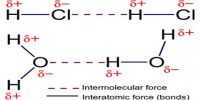Gibbs Free Energy ‘G’:
According to II law of thermodynamics, inorder to predict the spontaneity of a process entropy of universe is considered. ΔSunivers is the sum of ΔSsystem and ΔSsurroundings. It is difficult to determine ΔSsurroundings in most of the physical and chemical processes. Therefore a thermodynamic function which reformulates the spontaneity criterion considering only the system under study is required.
For this purpose, “a free energy function” has been introduced by II law of thermodynamics. The free energy function, called the Gibbs free energy function, denoted by the symbol ‘G’ is mathematically defined as,
G = H – TS
where H = enthalpy or heat content of the system, T = Temperature in Kelvin and S = entropy
This expression is valid for constant temperature and pressure processes.
In an isothermal process, if ΔH and ΔS are the changes in enthalpy and entropy of the system, then free energy change ΔG is given by,
ΔG = ΔH – TΔS
If 1 and 2 refer to the initial and final states of the system during the isothermal process, then
ΔG = (G2 – G1) = (H2 – H1) – T(S2 – S1)
from I law of thermodynamics
ΔH = ΔE + PΔV
Therefore ΔG = ΔE + PΔV – TΔS.
For a spontaneous process, the enthalpy change at constant pressure will be negative. This is because in an exothermic process, the enthalpy of the final state (H2) is lower than the enthalpy of the initial state (H1) so that (H2 – H1) is negative and the process take place spontaneously to attain the lower enthalpy state. Similarly, the entropy change (ΔS) increases in a spontaneous process since entropy of the final state S1 will be greater than the initial state S1 so that (S2 – S1) = ΔS, is positive. Combining negative ΔH and positive ΔS, in the expression for free energy change ΔG, at constant temperature, the overall magnitude of ΔG becomes negative for a spontaneous process. Here, ΔH and ΔS terms refer only to the system.
ΔG = ΔH – TΔS










